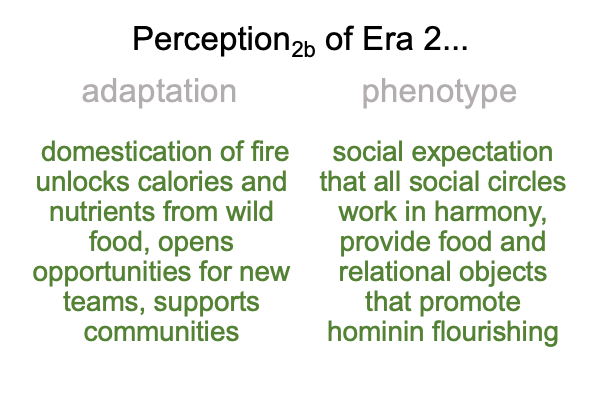0346 During the era of collective intentionality, humans become who we evolved to be.
Tomasello taps into that long-forgotten world by reviewing research into the cognitive abilities of newborns and infants. They start to pantomime and to point. But, as they learn speech-alone talk, they pantomime less and less. They continue to point.
This behavioral trend tells me that speech-alone talk usurps the pantomime (or iconic) aspect of hand talk.
Also, it tells me that speech-alone talk can never deliver the pointing (or indexal) aspect of hand talk.
0347 Spoken words point to… what?.. the presence of a speaker?
And, the images that spoken words provide, what of these?
0348 Are they illusions of reference?
Spoken words are codes that trigger decodings of what we imagine the referent must be.
With hand talk, the referent becomes obvious. The referent is what the pantomime imitates. A part stands for the whole. Both the part and the whole are real. We innately anticipate words to be pictures of something so real that it can be imaged and indicated.
With speech-alone talk, the referent of a word is not so obvious. Yet, we innately anticipate that it is. For this reason, civilizations fashion artifacts that validate the reference that we project into our spoken words. The validation works, until, of course, it doesn’t.
0349 Language evolves in the milieu of hand-talk. Technically, language consists of two related systems of differences,parole (talk) and langue (mental processing of talk). Grammar consists of symbolic operations within a fixed and finite system of differences (also known as “a symbolic order”). In terms of semiotics, in linguistic hand talk, the natural sign-qualities of symbol operate unnoticed below the surface of manual-brachial icons and indexes.
Hand-talk words picture and point to their referents. Yet, once hand-talk becomes fully linguistic among all social circles, nonsensical statements, such as “The grass has eyes.”, open novel cognitive territories beyond the range of sensible construction. Sensible construction is mandatory in teams. But, what about community?
A community demands larger cognitive spaces.
Nonsensical statements allow the social construction of evocative judgments that carry meaning beyond literal decoding. “The grass has eyes.” may warn about snakes in the area. It may also be a warning about a particular community member.
0350 What brings all of the above into play?
The domestication of fire does.

0351 With the domestication of fire, cooking provides calories and nutrients not available in raw food. More foods become edible with cooking. A huge expansion of teamwork is called for. More teams mean larger brains and larger groups.
Prior to fire, hominins undoubtedly engaged in teamwork for culinary practices that are currently not imagined (and perhaps, may be unimaginable to our civilized minds). There is a fine art to finding the right conditions for allowing food to rot and still be edible. Rotten food may be more nutritious than raw. After all, it is predigested… or… something like that… and maybe seething with protein-rich edible bugs. Each new trick of food preparation calls for a new team to perfect the methods. Each successful team increases the reproductive success of its team members and selects for physiology and temperament and cognitive capacities that make the methods more and more intuitively natural.
0352 Fire is more than icing on the cake of Acheulean food preparation.
Fire unlocks calories and vitamins by compromising the cellular integrity of raw foods.
No wonder fire-cooked food tastes delicious.
0353 Fire unlocks another opportunity. Now, talk no longer belongs to each team (15). Everyone sits around the fire after a big cooked meal. Talk itself becomes something like a team sport. Talk becomes a communal activity.
Steven Mithen, in Prehistory of Mind (1996), discusses a transition from minds built like Romanesque cathedrals to minds built like Gothic cathedrals. The Romanesque cathedral has a relatively small nave and is ringed by (almost) free-standing chapels. This reminds me of hand-talk locked in teams during the era of joint attention. The Gothic cathedral has a huge nave with small chapels on the sides. This reminds me of hand-talk opening to all in the community, so that fully-linguistic hand-talk changes all the social circles, including teams.
0354 Tomasello does not dabble with such metaphors. He notes that hominin society in the era of collective intentionality may be characterized by two dimensions.
The first dimension is synchronic. To me, that means, at every now, the social circles of family (5), intimate friends (5), teams (15), bands (50), communities (150), along with the nascent mega-bands (500) and tribes (1500) appear, to any individual, something like the tree of life.
The second dimension is diachronic. To me, that means, at every passage, the social circles work in tandem to achieve coherence, resolution and harmony, not with some explicitly abstracted formulation of a necessary order, but with the lives of all present, past and future. The tree of life has always been there. The tree of life will always be there.
0355 Oh, forget the metaphor.
Tomasello’s two dimensions concern the transmission of cultural practices. The word, “conventionalization”, applies.
0356 How does conventionalization come to be?
Obligatory collaborative foraging is so productive that the era of joint intentionality saw the destabilization of two demographic factors. First, as the number of teams increase and as teams become more and more productive (by selective breeding, so to speak), the size of the band (50) increases to the size of a community (150). The hominin brain increases in size proportionately.
The second is that, as the number of communities increase, intergroup competition begins. Intergroup competition becomes a proximate niche in hominin evolution.
0357 The era of joint intentionality overflows into the era of collective intentionality.
